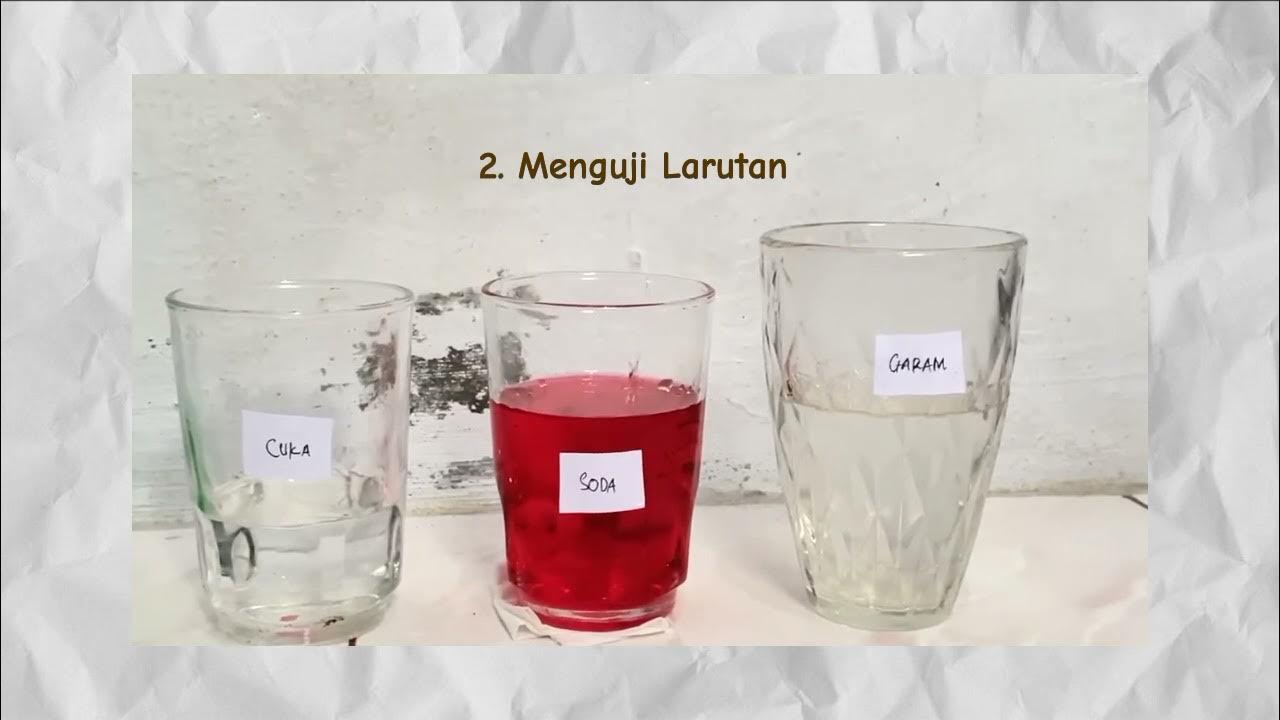Praktikum Kimia | Uji Daya Hantar Listrik Larutan Elektrolit Dan Non Elektrolit
Summary
TLDRThis video demonstrates a series of experiments to show the electrical conductivity of different solutions, emphasizing the distinction between electrolytes and non-electrolytes. The group presents various substances, such as isotonic drinks, acetic acid, salt solution, lime juice, sugar solution, and detergent, testing their ability to conduct electricity based on ionization. The results highlight that strong electrolytes, like salt and detergent, exhibit strong conductivity, while weak electrolytes, like vinegar and lime juice, have weak conductivity, and non-electrolytes like sugar do not conduct electricity at all.
Takeaways
- 😀 Isotonic drinks have weak electrical conductivity due to partial ionization, making them weak electrolytes.
- 😀 Acetic acid (vinegar) solutions also have weak electrical conductivity because of partial ionization, categorizing them as weak electrolytes.
- 😀 Salt solutions exhibit strong electrical conductivity due to complete ionization, making them strong electrolytes.
- 😀 Lime juice demonstrates weak electrical conductivity as it undergoes partial ionization, so it is a weak electrolyte.
- 😀 Sugar solutions do not have electrical conductivity because they lack free ions and do not undergo ionization, making them non-electrolytes.
- 😀 Detergent solutions show strong electrical conductivity due to perfect ionization, making detergents strong electrolytes.
- 😀 Electrical conductivity in a solution depends on the degree of ionization of the solute.
- 😀 A lamp lighting up brightly indicates high ionization and strong electrical conductivity.
- 😀 A lamp dimming or staying off indicates low ionization and weak electrical conductivity.
- 😀 The presence of bubbles in a solution is a sign of ionization, which is linked to electrical conductivity.
- 😀 The behavior of different solutions, like isotonic drinks, acetic acid, and detergents, helps demonstrate the varying strength of electrolytes.
Q & A
What is the main purpose of the experiment described in the video?
-The experiment aims to test and demonstrate the electrical conductivity of different solutions, such as electrolytes and non-electrolytes, by observing whether a lamp lights up based on ionization levels.
What is an electrolyte solution?
-An electrolyte solution contains ions that can move freely and conduct electricity. The degree of ionization determines whether the solution is a weak or strong electrolyte.
What characterizes a weak electrolyte?
-A weak electrolyte is a solution that undergoes partial ionization, resulting in weak electrical conductivity. Examples include isotonic drinks, acetic acid, and lime juice in the video.
What makes a solution a strong electrolyte?
-A strong electrolyte is a solution that undergoes complete ionization, resulting in high electrical conductivity. In the video, examples of strong electrolytes include salt solution and detergent.
Why does an isotonic drink have weak electrical conductivity?
-An isotonic drink has weak electrical conductivity because it undergoes partial ionization, meaning only a small number of ions are available to carry electrical charge.
What happens when acetic acid (vinegar) is dissolved in water?
-When acetic acid (vinegar) is dissolved in water, it partially ionizes, creating a weak electrolyte that shows weak electrical conductivity, as described in the video.
Why does salt solution have strong electrical conductivity?
-Salt solution has strong electrical conductivity because it completely ionizes, meaning all of the salt dissociates into ions that can carry electrical charge, making the lamp light up brightly.
What is the reason the lamp does not light up with lime juice?
-The lamp does not light up with lime juice because it undergoes partial ionization, making it a weak electrolyte with insufficient ion movement to conduct electricity.
Why does sugar solution not conduct electricity?
-Sugar solution does not conduct electricity because it does not ionize in water, meaning there are no free ions available to carry an electrical charge.
How does detergent behave in terms of electrical conductivity?
-Detergent behaves as a strong electrolyte because it undergoes complete ionization, resulting in high electrical conductivity, as observed in the experiment where the lamp lights up brightly.
Outlines

This section is available to paid users only. Please upgrade to access this part.
Upgrade NowMindmap

This section is available to paid users only. Please upgrade to access this part.
Upgrade NowKeywords

This section is available to paid users only. Please upgrade to access this part.
Upgrade NowHighlights

This section is available to paid users only. Please upgrade to access this part.
Upgrade NowTranscripts

This section is available to paid users only. Please upgrade to access this part.
Upgrade NowBrowse More Related Video

Percobaan Uji Daya Hantar Listrik Larutan

video praktikum sederhana " Larutan Elektrolit dan Non elektrolit"

Larutan Elektrolit dan Reaksi Redoks • Part 1: Larutan Elektrolit dan Nonelektrolit

Praktikum Uji Daya Hantar Listrik (Larutan Elektrolit dan Non Elektrolit)

SIFAT KOLIGATIF LARUTAN : KENAIKAN TITIK DIDIH

What Are Electrolytes?
5.0 / 5 (0 votes)